For many in the Formula One paddock, the Circuit de Barcelona-Catalunya is almost a second home thanks to the sheer amount of testing done at the 4.675km track.
Located roughly 30km outside of the city centre, the fastest show on four wheels has been coming to this venue ever since 1991, though this Mediterranean destination’s F1 history can be traced back further to 1969 when racing took place on the Montjuïc street circuit.
Welcoming 9.5 million tourists in 2019, there’s something for everyone in Spain’s second city – join us as we get rowdy with Gaudi and guide you through what you can expect…
Sports
It’s hard to talk about this place without mentioning football. With the Spanish Grand Prix typically falling right at the end of the LaLiga season, FC Barcelona might just be in action at their iconic Camp Nou – the largest stadium in Europe.
However, given the Blaugrana’s remarkable history, there is plenty of silverware on show in their museum if you can’t catch a game. Barcelona is not a one-club city, though, as RCD Espanyol also play in Spain’s top flight.
FC Barcelona’s Més Que Un Club (More Than A Club) motto rings true when you realise they also have basketball, handball, rugby, ice hockey, roller hockey, and futsal teams that all compete at different times throughout the year.
The host city of the 1992 Summer Olympics, many of the venues remain across the city 30 years on and are open to the public.
Neighbourhoods
The Catalan capital is home to many cool neighbourhoods that each have their own distinct characteristics. Arguably the most famous is the Gothic Quarter, or Barri Gòtic, which boasts some of the oldest shops and architecture in the city, and its quiet side streets can provide a welcome break from the hustle and bustle of La Rambla.
L’Eixample is home to a few more high-end stores and boutiques, but they are hardly a distraction from two of Antoni Gaudi’s finest works, La Pedrera and Casa Batlló, plus his still unfinished masterpiece, La Sagrada Família.
El Raval might just take the title of Barcelona’s most vibrant district, home to Mercat de la Boqueria – the city’s busiest local market, which is a must-visit for a true taste of the region.
Nature
Parc de Montjuïc offers an escape from the noise of the city centre and hosts any number of public spaces and gardens, such as the Jardí Botànic and Jardins de Mossèn Costa Llobera, the latter being home to over 800 different types of cactus.
There’s the added bonus of being able to walk the former Montjuïc street circuit, which meandered its way around the park. Our founder, Sir Frank Williams, whose own F1 journey started here in 1969, once described Montjuïc as “a great circuit for drivers requiring much courage…definitely for men and not for boys.”
Sitting atop the park is the 17th-century Castell de Montjuïc, which offers spectacular views over the city and far along the coast. In the distance, you will spot Serra de Collserola natural park, a short 15-minute ride from the centre where you can immerse yourself in local wildlife on its stunning hiking trails.
Art & Culture
With a rich history, Barcelona is a world-renowned destination for art and culture. Gaudi’s work is dotted throughout the city, with Parc Güell a superb display of his work in a natural setting.
There are numerous galleries and museums in the city, showcasing the likes of Pablo Picasso and Salvador Dalí. Free art is also all around, from modern graffiti to classic sculptures and mosaics.
Shopping
Catalonia’s capital is also home to one of the biggest open-air shopping routes on the continent – the Barcelona Shopping Line – which winds its way through the city over 5km through several different districts.
Located in the heart of the city is Plaza de Catalunya, where you’ll find the big brands of European fashion and department store chains, as well as some smaller names. La Rambla spurs off from this central square and is the place for your souvenirs.
Food
From local tapas bars, Michelin Star restaurants and local Catalan cuisine, there truly is something for every palate. Why not indulge yourself in a food tour, just make sure you save yourself enough room!
Authentic Spanish dishes such as Paella and Patatas Bravas are widely available, and given the coastal setting, the seafood is well worth a try.
The previously mentioned Mercat de la Boqueria will stimulate your senses, and whilst you’ll find the tourists' favourites towards the front, head further back for fresh fruit, the latest catch and a wide variety of cheese and meat.
Drink & Nightlife
Each neighbourhood brings with it its own unique sample of nightlife, so if you’re thinking about heading to one of the standard big clubs, think again.
Looking to toast a successful Grand Prix weekend? Do so with one of the many refreshing local beers, perfect for a warm Mediterranean evening.
Getting Around
With an extensive metro and bus network, every corner of this great city is easily accessible, with the bonus that you’ll get there pretty quickly too.
Heading to the circuit from the city centre? Taking the train is the most popular way to get there, with the closest regional station being Montmelo – about a 30-minute journey with an added half an hour walk. There is also a bus that runs to the circuit from the central bus station on race weekends.
Other Tips
Language: Spanish and Catalan
Currency: Euro (EUR)
Weather: Enjoying a Mediterranean climate, Barcelona is cooler in the summer but warmer in the winter than most other Spanish coastal resorts. With the race taking place in May, an average high of 21.8°C makes it one of the best times of year to visit.
Related Tags:
Powered By
© the Williams Group, under licence to Williams IP Holdings LLC
Williams Grand Prix Engineering Limited is a company registered in England and Wales under company number 1297497.
Its registered office is at Grove, Wantage, Oxfordshire, OX12 0DQ
Powered By







